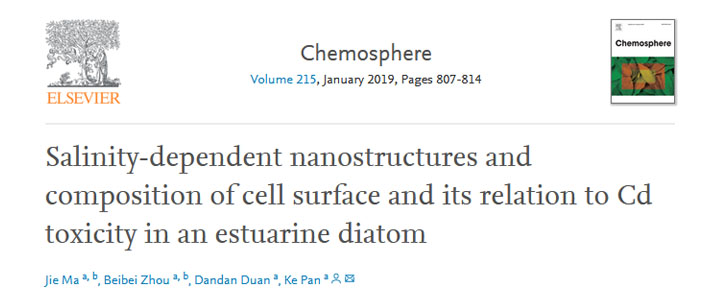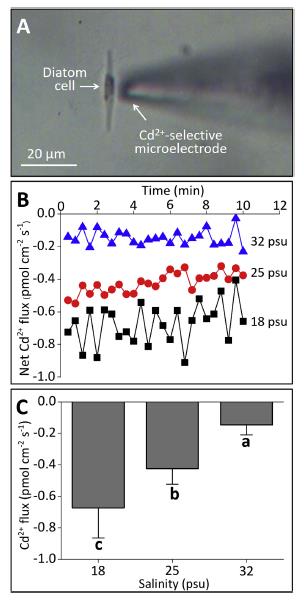Chemosphere :深圳大學丨鹽度調控的海洋硅藻細胞表面鎘離子流
NMT是基因功能的活體檢測技術,已被31位諾貝爾獎得主所在單位,及北大、清華、中科院使用。

期刊:Chemosphere
主題:鹽度調控的海洋硅藻細胞表面鎘離子流
標題:Salinity-dependent nanostructures and composition of cell surface and its relation to Cd toxicity in an estuarine diatom
影響因子:4.427
檢測指標:Cd2+流速
檢測部位:硅藻藻細胞
Cd2+流速流實驗處理方法:
不同鹽度的硅藻細胞
Cd2+流速流實驗測試液成份:
0.1mM KCl,0.1mM MgCl2, 0.5mM NaCl, 0.3mM 2-(N-morpholino) ethanesulfonic acid (MES), 0.2mM Na2SO4 and 0.1% sucrose, pH 8.0,8.9μM CdCl2
作者:深圳大學潘科、馬捷
文章簡介
鹽度是河口環境中變化較大的因子之一,會影響海洋主要初級生產力——硅藻與金屬之間的相互作用,之前研究發現這一影響主要由環境水化學變化引起。但卻忽略了鹽度也可能通過改變硅藻本身的生理生化狀態來影響其響應重金屬的過程。
此項研究模擬河口的鹽度梯度,在18,25,和32 psu三個鹽度下培養了新月菱形藻,在18 psu低鹽度時,施加8.9 μM的Cd2+對細胞生長的抑制強。但值得注意的是,Cd離子濃度的升高約一倍,引起的細胞生長抑制卻是約四倍,說明Cd重金屬毒性的增加可能存在著其它機制。從分布上看,大部分(>75%)Cd都吸附于細胞表面,表明新月菱形藻的細胞壁在初的Cd累積過程中有著重要的作用。
基于上述現象,研究利用非損傷微測技術測定不同鹽度培養的硅藻單細胞表面的Cd2+離子流。結果發現,硅藻細胞在低鹽度時細胞表面的Cd2+離子流速更快,而Cd2+吸收速率是影響其毒性主要因素。進一步結合其它物理化學手段終揭示了硅藻在不同鹽度下通過改變細胞壁的功能基團種類和數量來影響其吸附Cd的細胞表面化學機制。
此項研究為近海鹽度強烈變化條件下防控重金屬的污染和食物鏈傳遞提供了重要的理論依據。
 點擊添加圖片描述(多60個字)
點擊添加圖片描述(多60個字)
不同鹽度培養的新月菱形藻,細胞表面Cd2+離子流的差異性。負值表示吸收。
英文摘要
The interactions between metal and phytoplankton are affected by salinity in estuarine environments. While water chemistry is an important factor regulating the metal bioavailability in phytoplankton, the physiological adaptation of the algae cells may also change their intrinsic response to metals.
In this work, we tried to interpret the salinity-dependent Cd toxicity in a pennate diatom Nitzchia closterium from a biological side. As with many studies, we observed Cd toxicity to the diatom increased with decreasing salinity. However, changing free Cd ion concentrations may be partly responsible for the enhanced Cd toxicity.
Multiple evidences showed that diatom cells acclimated at low salinity had stronger intrinsic Cd adsorption capacity. Salinity significantly affected not only the nanostructures but also the biochemical composition in the cell surface of the diatom. Diatom cells grown at lower salinity had a lower surface potential, higher specific surface area, and more sulfur-containing groups in the cell wall, leading to stronger Cd binding capacity in the cells. Meanwhile, more Si was present as poly-silicic acid when the salinity decreased. The change of Si content and speciation in the cell wall are also considered a major reason for the variations of Cd surface binding.
Our study provided new clues for the salinity-dependent metal toxicity in marine diatoms.
中文摘要(谷歌機翻)
在河口環境中,鹽度影響金屬和浮游植物之間的相互作用。盡管水化學是調節浮游植物中金屬生物利用度的重要因素,但藻類細胞的生理適應性也可能改變其對金屬的內在響應。
在這項工作中,我們試圖從生物學的角度來解釋鹽度依賴的Cd毒性在戊二烯硅藻Nitzchia closterium中。與許多研究一樣,我們觀察到Cd對硅藻的毒性隨著鹽度的降低而增加。但是,改變游離Cd離子濃度可能是造成Cd毒性增強的部分原因。
多種證據表明,低鹽度適應的硅藻細胞具有更強的固有Cd吸附能力。鹽度不僅顯著影響硅藻的納米結構,而且顯著影響硅藻細胞表面的生化組成。在較低鹽度下生長的硅藻細胞具有較低的表面電勢,較高的比表面積和細胞壁中更多的含硫基團,從而導致細胞中更強的Cd結合能力。同時,當鹽度降低時,更多的Si作為聚硅酸存在。 Si含量的變化和細胞壁中的形態也被認為是Cd表面結合變化的主要原因。
我們的研究為海洋硅藻的鹽度依賴性金屬毒性提供了新的線索。
 您好, 歡迎來到化工儀器網
您好, 歡迎來到化工儀器網
